
Montgomery is a town and community in Powys, Wales. It is the traditional county town of the historic county of Montgomeryshire to which it gives its name and is within the Welsh Marches border area. The town centre lies about 1 mile (1.6 km) west of the England–Wales border. Montgomery Castle was started in 1223 and its parish church in 1227. Other locations in the town include The Old Bell Museum, the Offa's Dyke Path, the Robber's Grave and the town wall. The large Iron Age hill fort of Ffridd Faldwyn is sited northwest of the town and west of the Castle.
Berriew is a village and community in Montgomeryshire, Powys, Wales. It is on the Montgomeryshire Canal and the Afon Rhiw, near the confluence with the River Severn at grid reference SJ185005, 79 miles (128 km) from Cardiff and 151 miles (243 km) from London. The village itself had a population of 283. and the community also includes Garthmyl Hall and Refail.

Pontrobert is an ecclesiastical parish that was formed in September 1854. It comprises the townships of Teirtref and part of Nantymeichiaid in the parish Meifod, a portion of Cynhinfa which was in the parish of Llangynyw and portions of the townships of Fachwel, Llaethbwlch and Cadwnfa which were in the parish of Llanfihangel. The total area of this parish is 5,000 acres. As a result of this arrangement, Pont Robert is now divided between the present day Community Councils of Meifod, Llangyniew and Mawddwy. Pontrobert was within the historic county of Montgomeryshire, now forming part of Powys. The name Pontrobert is derived from Robert ap Oliver of Cyhinfa, who built the original bridge over the River Vyrnwy around 1700. An alternative Welsh name for Pontrobert is Pont y ddolfeiniog.

Thomas Penson, or Thomas Penson the younger was the county surveyor of Denbighshire and Montgomeryshire. An innovative architect and designer of a number of masonry arch bridges over the River Severn and elsewhere. He was the son of Thomas Penson the older,, who had been the county surveyor for Flintshire from 1810 to 1814, but had been dismissed when the bridge at Overton-on-Dee collapsed. Thomas Penson the younger, completed its replacement. Thomas Penson the younger had two sons: Thomas Mainwaring Penson and Richard Kyrke Penson, both of whom were architects and both practised in Chester

Dolanog or Pont Dolanog is an ecclesiastical parish or chapelry that was formed in October 1856. It comprises the townships of Dolwar in Llanfihangel portions of Coedtalog in Llanerfyl, Cynhinfa in Llangyniew and Gwaunynog in Llanfair Caereinion. The total area of this parish is 3,100 acres. Dolanog was within the historic county of Montgomeryshire, which now forms part of Powys, Wales. Dolwar Fechan in Dolanog was the home Ann Griffiths, the Methodist hymn writer.
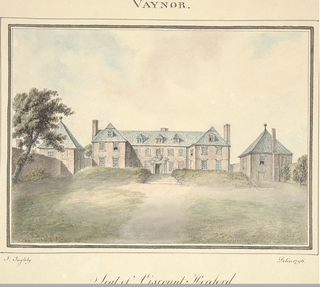
Price Devereux, 10th Viscount Hereford was a British Tory politician who sat in the House of Commons from 1719 to 1740 when he succeeded to a peerage as Viscount Hereford.

Price Devereux, 9th Viscount Hereford of Vaynor Park, Montgomeryshire and Ombersley Court, Worcestershire was a British Peer.

Leighton Hall is an estate located to the east of Welshpool in the historic county of Montgomeryshire, now Powys, in Wales. Leighton Hall is a listed grade I property. It is located on the opposite side of the valley of the river Severn to Powis Castle. The Leighton Hall Estate is particularly notable for the hall which was decorated and furnished by the Craces to designs by Pugin in his Houses of Parliament style, for the Home Farm, a model farm, which was to be in the forefront of the Victorian industrialised High Farming, and for the gardens which have their own Grade I listing on the Cadw/ICOMOS Register of Parks and Gardens of Special Historic Interest in Wales. Leighton Hall was also the birthplace of the much disparaged hybrid Cupressocyparis leylandii hedge tree. The hall is in private ownership and is not accessible to the public, although it can still be viewed from the road. The home farm is currently under restoration.
George Devereux was an English politician who sat in the House of Commons from 1647 to 1653.

Joseph Bromfield (1744–1824) was a notable English plasterer and architect working in the West Midlands and in Central and Northern Wales in the late Georgian period. He was Mayor of Shrewsbury in 1809.
Nantcribba is a township in the parish of Forden in the historic county of Montgomeryshire and now in Powys It is also the site of Nantcribba Castle which was built by the Corbett, Barons of Caus, of Caus Castle in Shropshire. To the south of the Castle site was Nantcribba Hall, which was owned by the Devereux family and the Marquises of Hereford. In the 19th century Nantcribba became part of the Leighton Hall estates.
Poundley and Walker or John Wilkes Poundley and David Walker were a land surveyors and architects’ partnership with offices at Black Hall, Kerry, Montgomeryshire and at Unity Buildings, 22 Lord Street, Liverpool. The partnership was established probably in the mid-1850s and was dissolved in June 1867. The partnership was involved with large country estate building projects, church and civic buildings and some civil engineering. They specialized in building model farms. J. W. Poundley was also the county surveyor for Montgomeryshire from 1861–1872. The architect, canal and railway engineer, T. G. Newnham appears have been associated with the partnership.
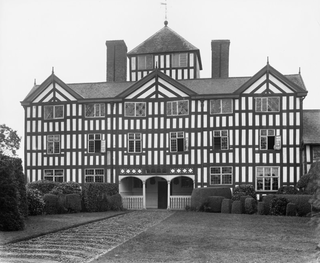
Lymore, or Lymore House or Lodge was demolished in 1931. It stood in Lymore Park, one mile ESE of Montgomery, Powys, Wales. The house was a large half-timbered house built by Edward Herbert, 3rd Baron Herbert of Chirbury, c. 1675, to replace the family residences in Montgomery Castle and Black Hall in Montgomery. The house, which had been uninhabited but maintained for many years, was used for an event in 1921, when one of the floors collapsed with disastrous consequences, resulting in demolition in 1931. The Earls of Powis still own and maintain the park. The park includes the grounds of the Montgomery Cricket Club, which is the oldest cricket pitch in Montgomeryshire and Offa's Dyke forms its eastern boundary. It is listed on the Cadw/ICOMOS Register of Parks and Gardens of Special Historic Interest in Wales.
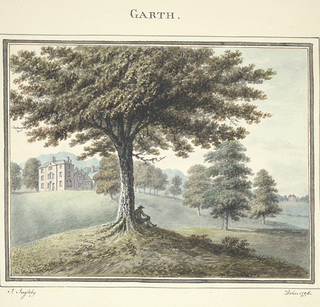
Garth was an important early gothic revival house in the township of Garth in Guilsfield in Montgomeryshire. In the 18th century it became the home of the Mytton family who had originally been Shrewsbury drapers, who derived their wealth from the Montgomeryshire woollen industry. They had settled at Pontysgawrhyd in Meifod and at Halston in Shropshire. The most famous members of the family were General Mytton, the Parliamentary Commander in the Civil War in the Marches and “Mad Jack Mytton”, the eccentric 19th-century squire of Halston. In 1809 a grandiose rebuilding scheme was started by Richard Mytton. However, this together with extravagant furnishing of the new house and reckless purchasing of surrounding farms, which culminated in the purchase of the Trefnannau estate in 1812 for £33,625, led to financial problems. The Myttons struggled to afford to live in style in this house, and it is likely that Richard Mytton's outlay on lands, the building of Garth and its furnishing cost nearly £100,000 The family continued to live in the house until it was damaged by fire in 1922. Thereafter, there was a gradual decline, leading to the sale of the remainder of the estate in August 1945 and the demolition of the house for salvage during the winter of 1946–7. The remnants of the garden and park are listed at Grade II on the Cadw/ICOMOS Register of Parks and Gardens of Special Historic Interest in Wales.

St Beuno’s Church is the parish church of Berriew, in the historic county of Montgomeryshire, now Powys. The church stands in an almost oval churchyard in the centre of the village. The original church was a single-chamber, with a wooden west bellcote and a northchancel chapel. This church was replaced in 1803-4 with a larger brick church by the architect John Hiram Haycock of Shrewsbury. It was of brick with stone dressings, and had the entry under a pinnacled west tower to a galleried nave with four round-headed windows a side. The church was largely rebuilt by his grandson, Edward Haycock, Junior in 1876. It consists of a nave, aisles, chancel, north porch, and west tower The west tower has the doorway blocked, stone facing for brick, and Gothic windows, except for the circular ones on its second stage.

St Beuno's Church, Bettws Cedewain lies within the historic county of Montgomeryshire in Powys. The church occupies a prominent position overlooking the village of Bettws Cedewain, on the northern edge of the valley of the Bechan Brook which flows into the River Severn. Bettws is about 9 miles to the south-west of Welshpool. The church is a single-chambered structure with a western tower, set in a near-circular churchyard. A campanile or bellcote was added to the earlier tower in the early 16th century by the vicar, John ap Meredyth, whose memorial brass remains in the church to-day. The church was extensively rebuilt in 1868 under the supervision of the architect William Eden Nesfield. This included a complete rebuild of the upper part of the tower
Trewern Hall or Trewern Farmhouse is a country house in Montgomeryshire, Wales, close to the Shropshire border. It is on a spur in the floodplain of the River Severn, in the Trewern community area of what is now Powys, to the north of the A458 road from Shrewsbury to Welshpool. It is a fine example of a Severn valley half-timbered house. The Grade II* listed hall was occupied by the Lloyd, Francis and Whittaker families. In 1985–86 and 1993–94 it was extensively restored with some remodelling by the architect M. J. Garner for Murray Ll. Chapman.
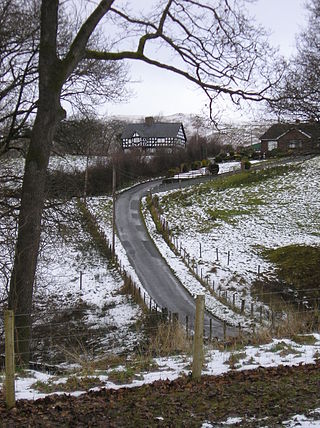
Plasau Duon or Plasauduon is a timber-framed house, formerly in the parish of Carno, but now within the area of the community council of Caersws in the historic county of Montgomeryshire, and now in Powys, Wales. It is located on a site above the left bank of the Afon Carno, on a farm road leading off the lane from the A.470 to Bwlch-y-garreg. It is a fine example of a ‘’Severn Valley’’ house and has a Grade II* listing. It is likely to have been built in the second half of the 16th. century.
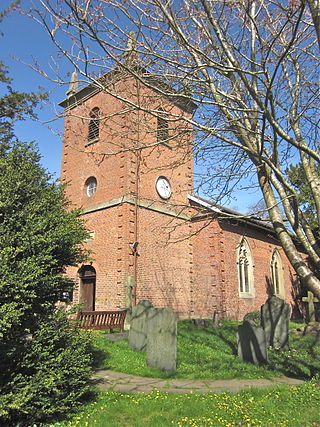
St Llwchaiarn's church, Llanllwchaiarn was the parish church of Llanllwchaiarn, now within the community of Newtown with Llanllwchaiarn and lies within the historic county of Montgomeryshire in Powys. The church occupies a position on rising ground overlooking the river Severn and is to the north east of Newtown. The present church was rebuilt in 1816. In 2011 the medieval carved screen, originally from St Mary's church in Newtown, was re-positioned in Llanllwchaiarn church

Architecture of Wales is an overview of architecture in Wales from the medieval period to the present day, excluding castles and fortifications, ecclesiastical architecture and industrial architecture. It covers the history of domestic, commercial, and administrative architecture.




















